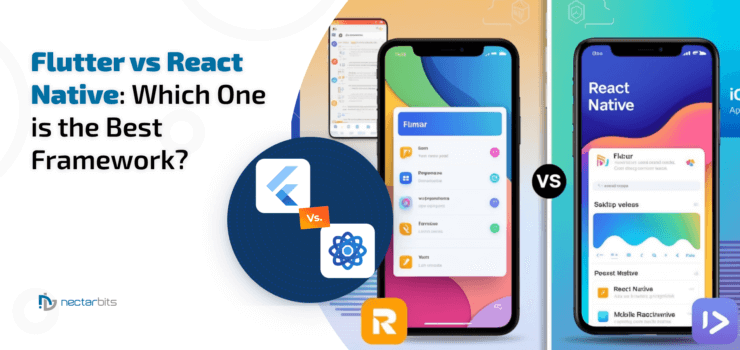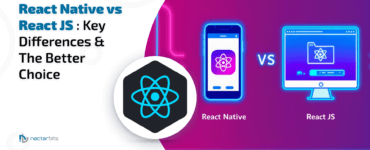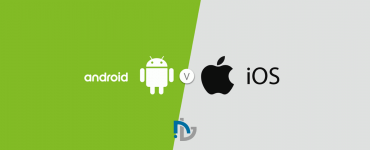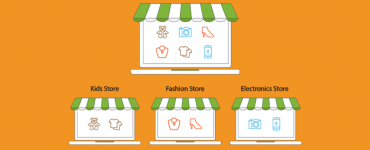Choosing the right framework for your cross-platform mobile app can be tough. Both Flutter and React Native offer compelling features and have earned their place in the development world. This detailed comparison will help you weigh their strengths and weaknesses to make the best choice for your project. Dive into the pros and cons of developing mobile apps in React Native and Flutter to learn more about the platform best suited for your unique requirements.
What are cross-platform app development frameworks?
In the rapidly evolving world driven by digital solutions, the popularity of smartphones has made cross-platform app development a necessity for propagating your brand and its utilization across a wider demographic of users. Gone are the days of developing apps solely based on a singular, unique platform, as newer app development frameworks support multiple platforms natively, making your app more versatile and consistent across iOS and Android. This is why almost 50% of all mobile apps in 2023 were made using cross-platform frameworks.
Why should you choose the right platform?
While these technologies continue to improve, the pragmatic implementation of the app and its development cycle largely depend upon your choice of framework. This is why it is paramount for any digital service provider to choose the right platform before embarking on their app development journey. An informed comparison and selection between such frameworks will signify your finalized application’s quality, consistency across platforms, and overall development time and cost.
Flutter VS React Native – A detailed overview
Two of the most popular choices in this segment are Flutter and React Native. Both are known for their reliability and continual improvement over time, offering better versatility, tighter integration with the OS, and more consistency across different platforms.
Choosing between these two frameworks would be easy and binary in an ideal world. Still, the reality is that both platforms offer their pros and cons regarding their utilization and execution. Both are powerful tools capable of building amazing cross-platform applications, but they carry significant differences against each other that make them suitable for specific use cases and needs.
This is why it is integral to choose the right framework that suits your unique needs and priorities to ensure that you don’t encounter any issues in the future in terms of scalability, maintenance, and uniformity. Choosing between Flutter versus React Native in 2024 will directly decide upon your future strategy and the availability of choices in terms of your application’s user interface (UI) and user experience (UX).
What is Flutter and its benefits?
Known for its intuitive UI-oriented object-based programming, Flutter is the new kid on the block that has been steadily rising in popularity among developers, according to the latest Stack Overflow Survey and Statista. Its user interface is just as intuitive as the mobile apps it can help create for developers, with smooth, fluid animations, incredible visual effects, and a consistent native-like experience.
Google developed Flutter with a shorter learning curve, making it a great choice for people starting out on their journey of cross-platform app development and looking for an intuitive and helpful framework to assist them.
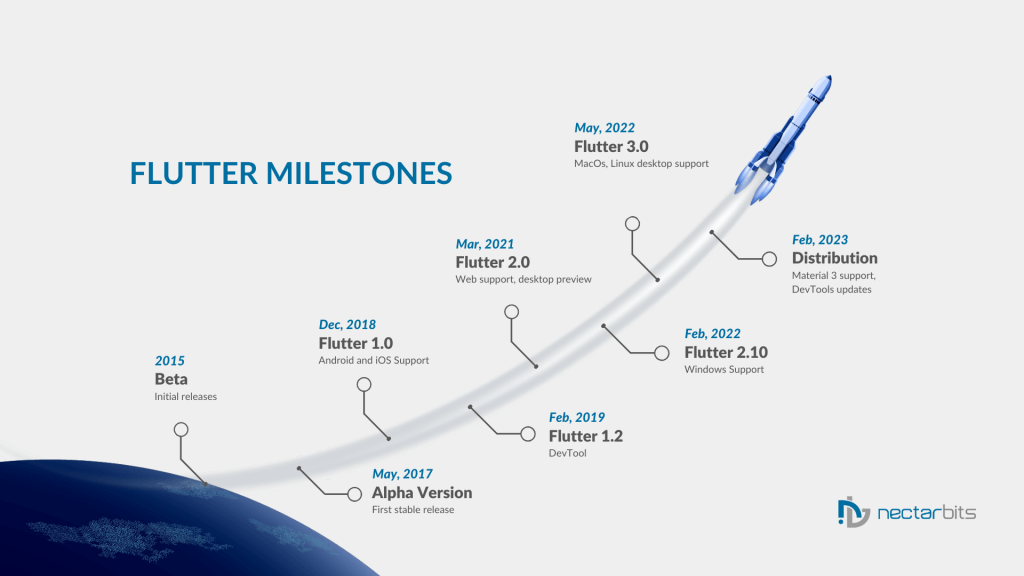
Popular features and benefits of Flutter:-
Some of Flutter’s most popular features are:-
- Hot Reload: An almost magical feature built into Flutter is the ability to instantly reflect your code changes in the app. Forget waiting for long compile times; just write your code and see it live. This makes development incredibly fast and efficient.
- Beautiful UI: Flutter’s built-in widgets and animation capabilities are a joy. This makes for a visually stunning UI that truly feels native without relying on unnecessary third-party libraries.
- Dart: While it’s a newer language, Dart is simple, clean, and powerful. This makes the language easy to learn and ideal for a new developer to build modern, performant applications.
- Single Codebase: This is the holy grail of cross-platform development. One free and open-source codebase for both iOS and Android means fewer developers, faster development cycles, and easier maintenance.
- Performance: Flutter compiles to native code, giving you a smooth, responsive user experience. It’s a great choice for apps that demand high performance.
- Rendering Engine: Flutter integrates its high-performance rendering engine, enabling higher performance and highly customizable dedicated widgets.
What is React Native, and why is it still popular?

Facebook’s alternative cross-platform app development framework is the classic React Native, a seasoned veteran that boasts a large community of passionate developers and an extensive library of dedicated components. The main advantage of React Native is that it uses Javascript as the basis of its functioning, allowing a large number of developers already familiar with this age-old language to pick up and use React Native for app development immediately.
This makes it a popular choice among existing developers fluent in Javascript aspiring to build apps for both iOS and Android through a singular codebase.
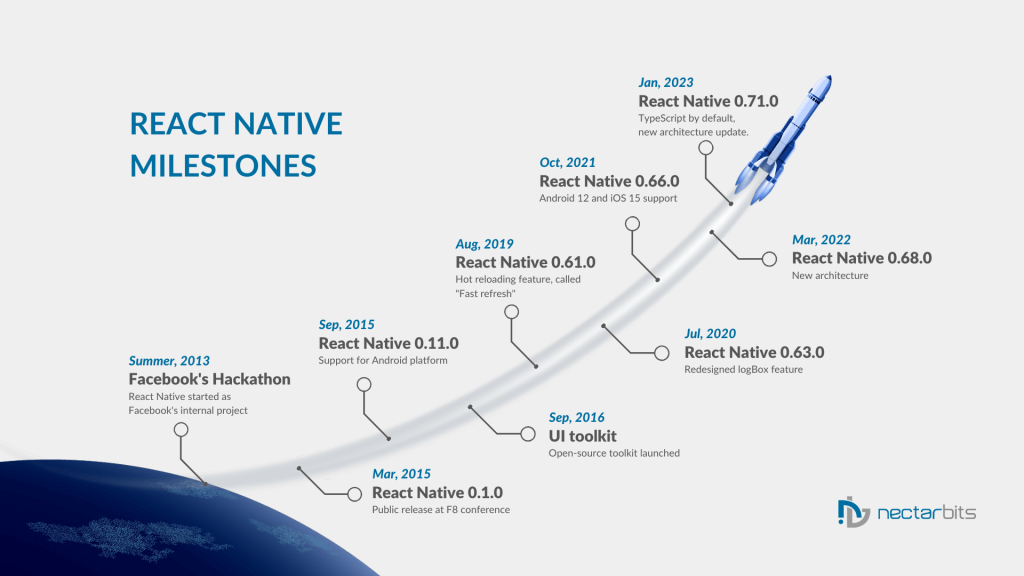
Popular features and benefits of React Native:-
Some of Flutter’s most popular features are:-
- JavaScript adoption: React Native leverages JavaScript, lowering the learning curve for developers with existing web development experience.
- Dedicated Community: React Native has a massive and vibrant community, offering an unparalleled wealth of resources, libraries, and existing support. This means that finding solutions and assistance to problems is easier, considering the extensive community-run forums and discussions surrounding the platform.
- Mature Ecosystem: The React Native ecosystem is vintage and prestigious. It has a vast collection of pre-built components and libraries, allowing developers to add features and functionality to their apps quickly.
- Native Performance: React Native bridges the gap between JavaScript and native components, resulting in apps that feel and perform like native apps.
Comparing Flutter VS React Native in terms of their popularity (2024)
It’s hard to exactly quantify the popularity of these two platforms in terms of what developers believe to be better in every manner, as each developer will choose to adopt their preferred framework based on fluctuating demographics like their experience in Javascript, localized popularity in their country, and their independent use-case.
That being said, we can deduce from statistical analysis of developers spread across the globe to check the framework’s overall adoption and gain a macro understanding of which platform is typically prone to be utilized on average in a commercial mobile app development project. This will help answer the question, “Which is the best cross-platform framework, Flutter or React Native?” for mobile app and software development.
Flutter VS React Native 2024 (Google Trends)
Google Trends showcases a steady rise in the popularity of Flutter, which is more frequently searched globally and has steadily gained traction in the last two years. This shows the increased interest in Flutter in comparison to React Native among both technical and non-technical user bases.
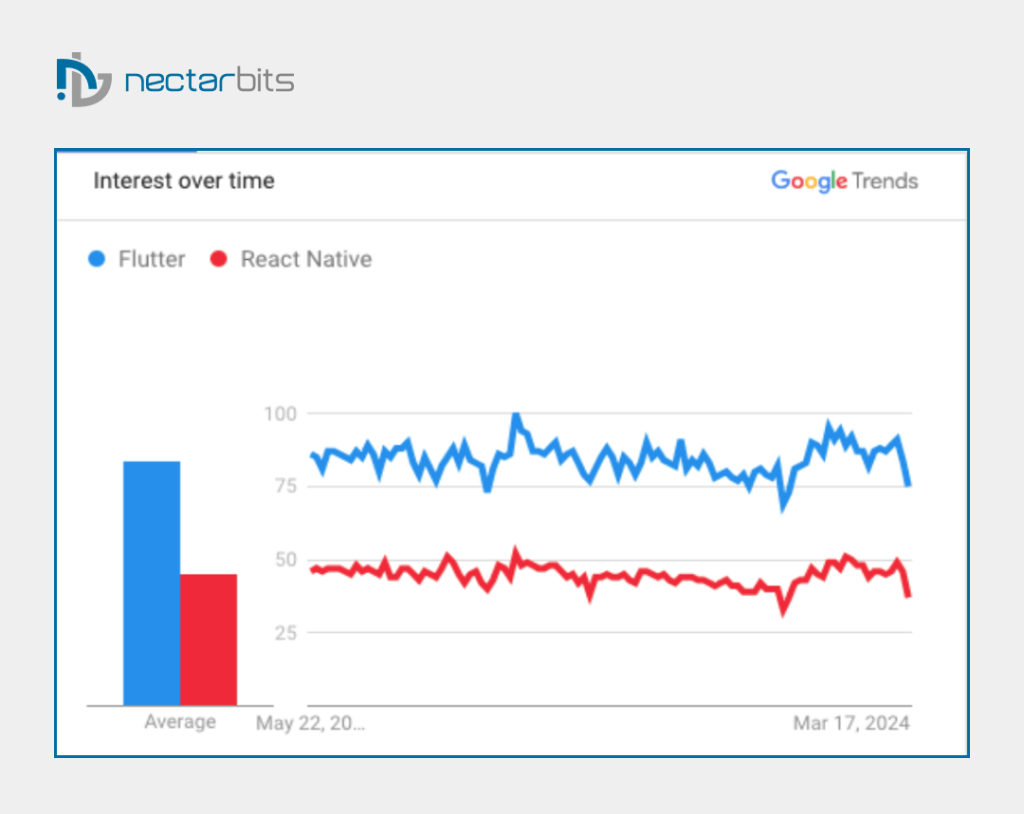
The yearly survey report by Stack Overflow showcases how the popularity of React Native and Flutter changes over time, particularly among seasoned developers. This helps us analyze the real-life utilization of both frameworks and their technical adoption across the globe. Pitting React Native against Flutter in the latest Stack Overflow survey shows that Flutter still tops React Native, according to responses from over 90k developers.
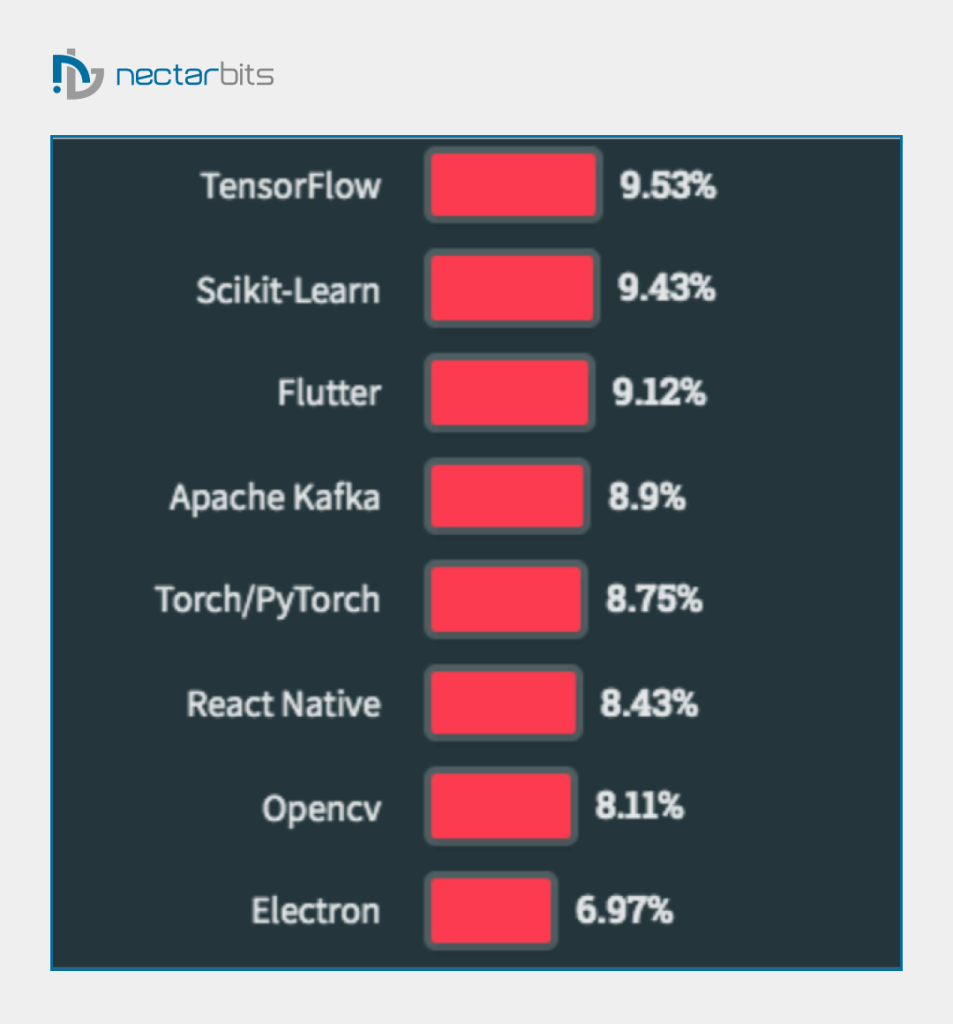
Flutter VS React Native and other cross-platform mobile frameworks (Statista)
Another developer survey shows how the popularity of Flutter VS React Native for app development changed over the years and their comparison to other prominent cross-platform mobile frameworks. This shows Flutter’s incredible growth over four years recently, alongside the decline in the popularity of React Native and other frameworks, signifying the dominance of Flutter in the space and its popularity.
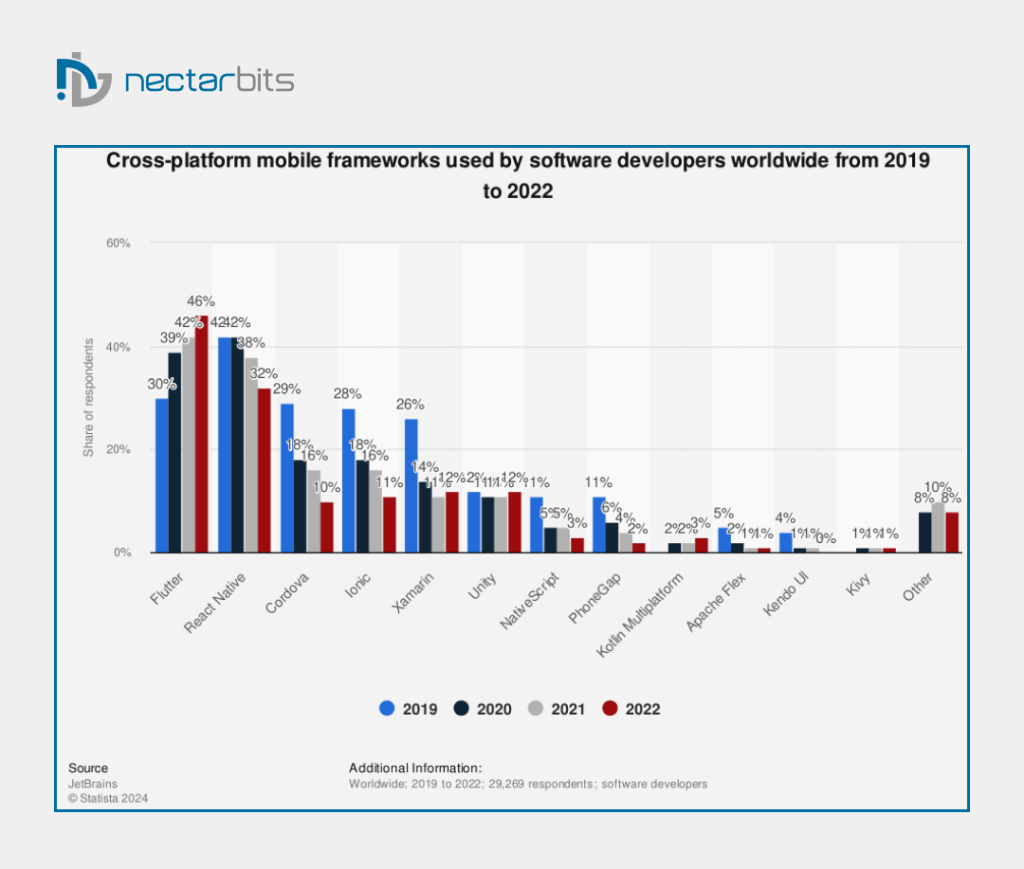
Which is better in 2024? Flutter VS React Native
Pros and Cons of Flutter
Even though Flutter is clearly becoming a popular choice among developers, both Flutter and React Native have their own benefits and drawbacks. While Flutter is more UI-centric and innovative in its widget customization through a dedicated engine, it is relatively new and thus has weaker community support. This forces the need for more custom Flutter app development and widget designing as Flutter is still expanding its third-party libraries.
Advantages of Flutter:
- Cross-platform development: Build for iOS, Android, web, and desktop with one codebase.
- Fast development: Hot reload lets you see changes instantly, speeding up development.
- Beautiful UI: Rich, customizable widgets for unique and appealing designs.
- Native features: Access device functionalities for a smooth user experience.
- Open-source and free: No licensing fees for commercial use.
- Faster time-to-market: Get your app launched quicker with efficient development.
- Great for MVPs: Build prototypes quickly to validate your app concept.
Disadvantages of Flutter:
- New technology: Still evolving, with some features under development.
- Larger app size: This can be an issue for users with limited storage.
- Fewer third-party libraries: This may require more custom development for specific features.
- Learning curve for devs: Dart is less common than JavaScript used in React Native.
- Limited corporate adoption: Finding Flutter developers might be more difficult.
- Potential performance trade-offs: These may not always match purely native apps.

Pros and Cons of React Native
Meanwhile, React Native is the more mature and nuanced platform built on the well-known JavaScript foundation, which makes it readily available to a large corpus of developers. However, its performance is subpar due to JavaScript bridging, and it proves to be more challenging and cumbersome in its implementation and customization of UI. React Native is also not as seamless as Flutter in terms of its discrepancies between Android and iOS, causing a reduction in consistency.
Here’s a quick rundown of React Native’s strengths and weaknesses:
Advantages of React Native:
- Faster Development: React Native’s code reusability and hot reloading features significantly speed up the development process compared to building separate native apps.
- Code Reusability: Many of your codebases can be shared between iOS and Android apps, reducing development time and costs.
- Native-like Performance: React Native apps can achieve performance close to native apps, delivering a smooth user experience.
- Large Community: React Native boasts a vast and active developer community that provides ample resources, support, and libraries.
- Third-party Library Support: The extensive ecosystem of third-party libraries simplifies development by offering pre-built components and functionalities.
- Hot Reloading: Similar to Flutter, hot reloading allows for near-instantaneous updates to the app during development, boosting productivity.
Disadvantages of React Native:
- Limited Native Features: Accessing some device-specific functionalities might require writing native code, increasing development complexity.
- Debugging Challenges: Debugging issues can be more intricate in React Native than purely native development.
- Not All-Encompassing: React Native might not be ideal for apps heavily reliant on unique native features or extremely high-performance requirements.
- Performance Considerations: While generally good, performance can be a concern for complex apps or those with intricate animations.
- Security Concerns: Security vulnerabilities might arise if not addressed properly during development, requiring extra vigilance.

Technology Stack of Flutter VS React Native
Both Flutter and React Native are popular choices for cross-platform mobile app development, but they take different approaches under the hood. Here’s a breakdown of their key tech stacks:
Language:
- Flutter: Uses Dart, a modern, object-oriented language with a syntax similar to Java or Kotlin.
- React Native: Leverages JavaScript, a widely used language for web development, allowing for code reusability with existing web projects.
UI Rendering:
- Flutter employs its high-performance rendering engine, resulting in smooth animations and a native-like feel. It compiles code Ahead of Time (AOT) for faster execution.
- React Native: Relies on native UI components for each platform (Android and iOS) for a more platform-specific look. It uses Just-in-Time (JIT) compilation.
Development Experience:
- Flutter: Offers a rich set of widgets and a strong focus on hot reload, enabling rapid development cycles. IDE support might be limited compared to React Native.
- React Native: Benefits from a vast JavaScript ecosystem and a wider range of IDEs. However, hot reloading might be slower than Flutter.
Here’s a table summarizing the key points:
| Feature | Flutter | React Native |
|---|---|---|
| Language | Dart | JavaScript |
| UI Rendering | Custom Engine (AOT) | Native Components (JIT) |
| Development Experience | Hot Reload, Focused Widgets | Larger Developer Community, More IDE Support |
Comparing Flutter and React Native according to their features
Pitting Flutter against React Native, we can see the following number of vital differences in both its interface and overall product output:
| Flutter | React Native |
|---|---|
| Flutter is intuitive and easy to understand. | React Native is a bit limiting and harder to learn |
| Unique and highly customizable widgets with a custom rendering engine | Uses Native UI widgets for higher consistency and allows deeper improvements |
| Built for cross-platform development, reducing development time with a dedicated library of prebuilt UI components | Potentially slower development cycle due to platform-specific tuning required for an error-free deployment |
| Requires the knowledge of proprietary Dart language | Requires the knowledge of Javascript, whichis more widely adopted |
| Faster performance but significantly larger file sizes | Slower performance due to Java bridging restrictions |
Popular Flutter Mobile Applications in 2024
Here are some of the most popular mobile applications today using Flutter as its framework for its development:-
- Amazon
E-commerce giant Amazon relies on Flutter and its intricate UI customization options to stay updated compared to competing platforms.
- Universal Studios
The highly customizable widgets Flutter presents allow Universal Studios to create next-gen experiences for its users.
- Google Pay
The entire suite of Google apps, including Maps, YouTube, and Google Pay/Wallet, is powered by Flutter. Security-intensive apps like Google Pay utilize advanced security encryption measures offered by the Flutter framework.
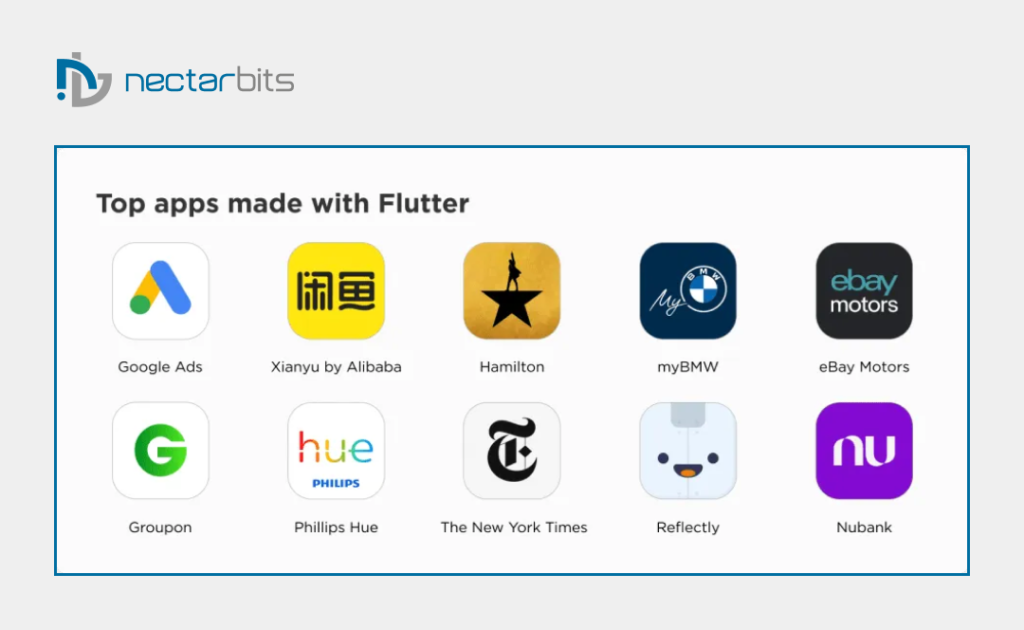
Popular React Native Mobile Applications in 2024
Here are some prominent applications using React Native for their development:-
Instagram uses the advanced library of existing widgets and compatibility offered by React Native to allow better optimization of its messaging and social-sharing utilities.
- Discord
New-age messaging app Discord, popular among teenagers and gamers, uses innovative widgets and React Native’s customizable UI to provide a fresh user experience.
- Tesla
Car management and bleeding edge auto-drive features available through class-leading security encryption are the requirements being fulfilled by React Native for Tesla and their mobile-app development needs across both iOS and Android.
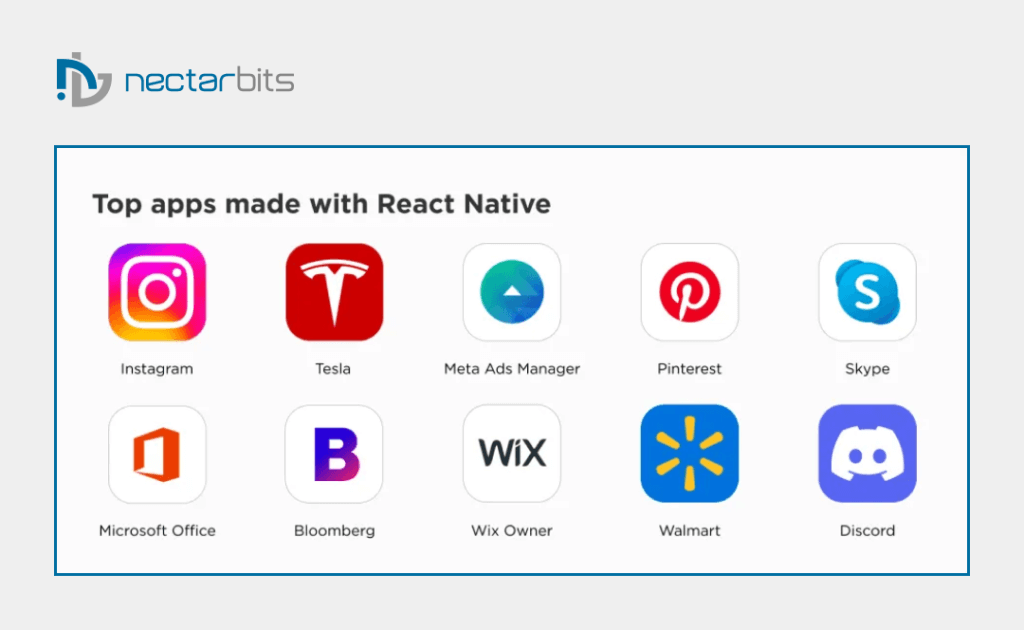
To know more about the development journey of such apps, check out our portfolio here!
Comparing the Development Cost of Flutter and React Native
Comparing average developer cost in the US between Flutter and React Native
While both Flutter and React Native are free and open source, the biggest chunk of your mobile app development budget will likely be spent on developer salaries. If you’re planning to build a permanent team, here is a general idea of the salary ranges for Flutter and React Native developers in the USA in 2024:-
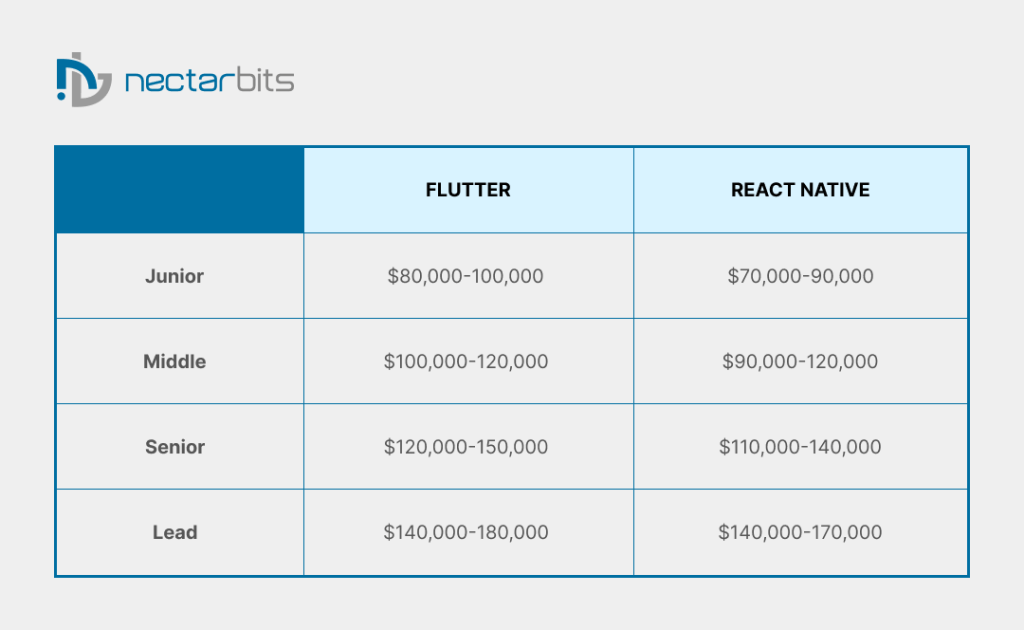
Comparing hourly rates of developers in the USA, Asia, and Eastern Europe
A great way to cut costs in terms of developer salary within both Flutter and React Native App development cycles is hiring developers for projects at an hourly rate. According to Upwork, here are the rates across multiple geographical markets in 2024:-
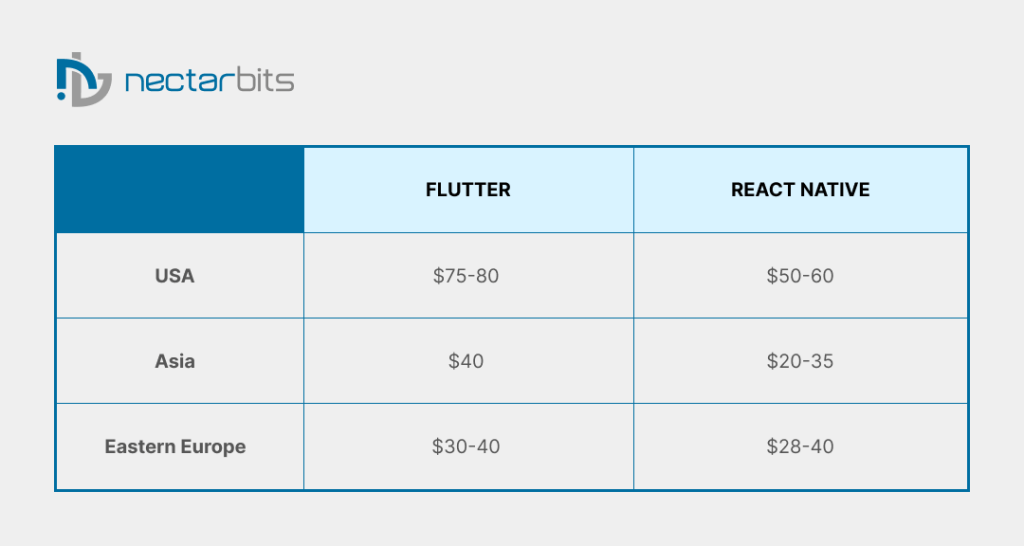
Suppose you are unsure about your development needs or require an expert developer for your next project at competitive rates. In that case, NectarBits provides both Flutter and React Native developers for your unique needs!
Conclusion: Choosing the Right Platform
Ultimately, Flutter and React Native are powerful tools for building amazing cross-platform apps. The key is to choose the right tool for the job, considering your project’s unique requirements and your team’s skillset. Pitting Flutter vs. React Native in 2024 forces a comparison between Flutter App Development and React Native app development based on a variety of different parameters.
While small to medium-sized projects can avail of either of these platforms, complex projects require a framework that can keep up with their requirements. The expertise of the programming language (Dart VS JavaScript) within the team and the importance of pre-existing widgets and community support are additional parameters that can dictate the right platform for your unique needs and IOS Android App development cycle.
| Choose Flutter if: | Choose React Native if: |
|---|---|
| You need a truly native-like experience with smooth animations and stunning visuals. | You have a large team with existing JavaScript expertise. |
| You are comfortable with Dart or want to learn a new language with a strong emphasis on simplicity. | You need a faster development speed for your projects. |
| You are developing a UI-intensive app with custom designs and animations. | You need access to a vast library of pre-built components and modules. |
Read More:- Angular VS React JS Comparison
Frequently Asked Questions (FAQs)
React Native’s speed has improved thanks to its switch to the JavaScript Interface (JSI). While Flutter might be slightly quicker, this difference might not stand out in many apps. The decision largely rests on your project’s unique needs.
The user-friendly nature of Flutter and ample problem-solving resources on platforms such as GitHub made it popular. Yet, finding seasoned Flutter developers might be hard. React Native, despite increasing competition, still has a wide-reaching community and rich libraries. The “superior” framework depends on project details, team skills, and future aspirations.
Flutter is a hybrid or cross-platform framework offering developers the chance to design apps with native-like UI elements. This method promotes code reuse and speedy development cycles versus entirely native solutions.
Yes, indeed! Flutter works smoothly with AI tech, enabling smart mobile app development. Our Mistral AI API client for Flutter (open-source) lets you add features like instant query responses and user-focused interactions. Check out our detailed guide for practical applications of AI in various mobile scenarios.
Flutter is a hybrid or cross-platform framework offering developers the chance to design apps with native-like UI elements. This method promotes code reuse and speedy development cycles versus entirely native solutions.


